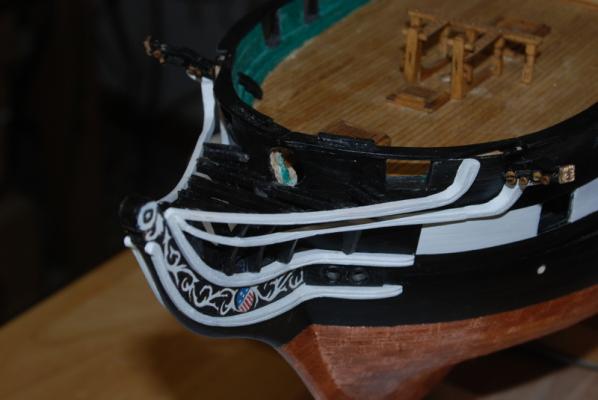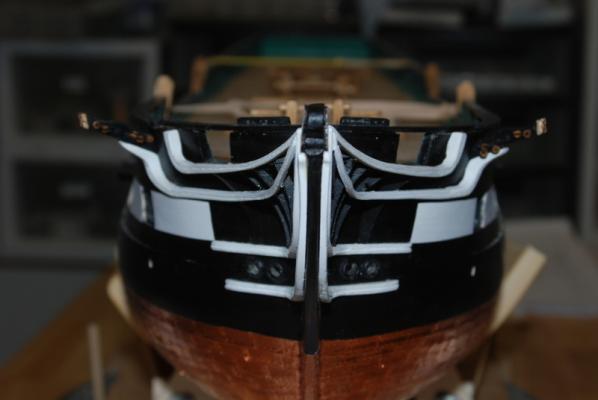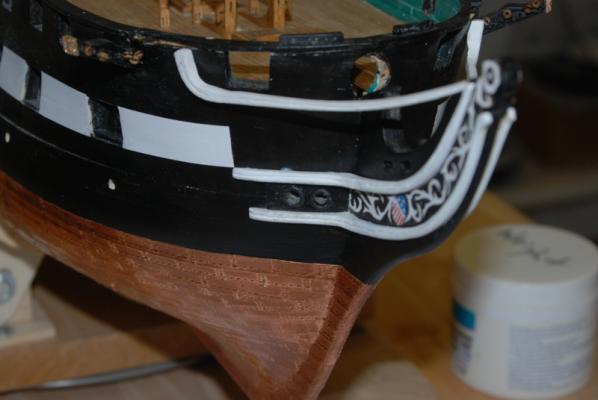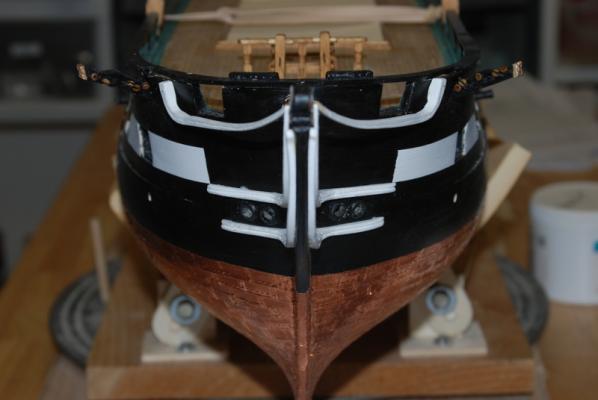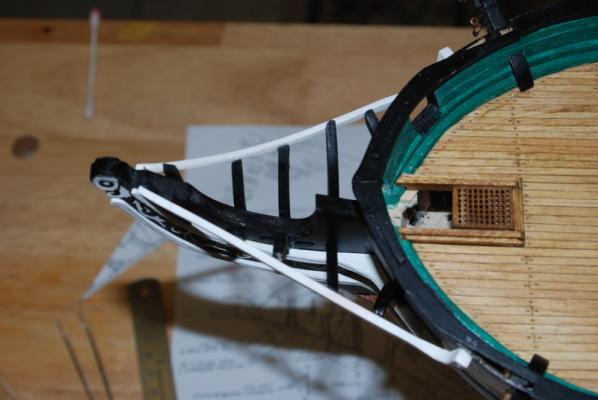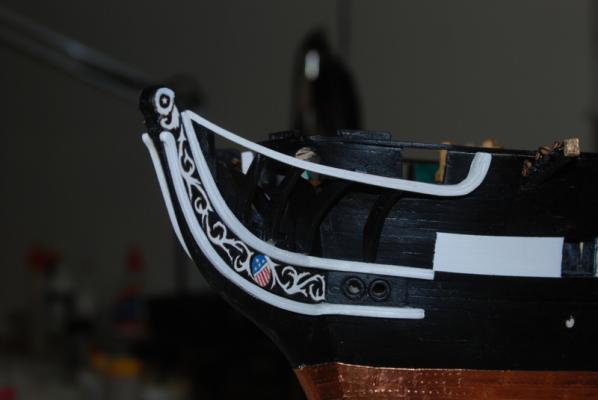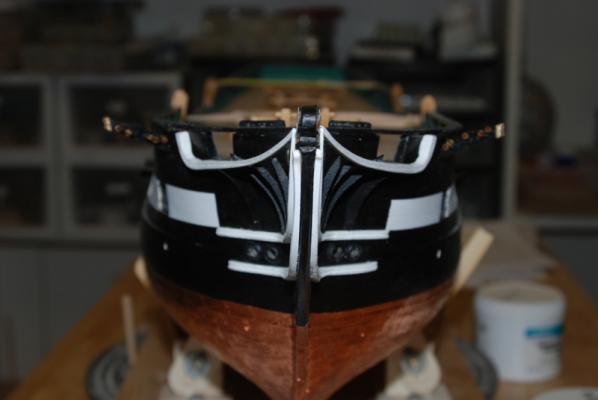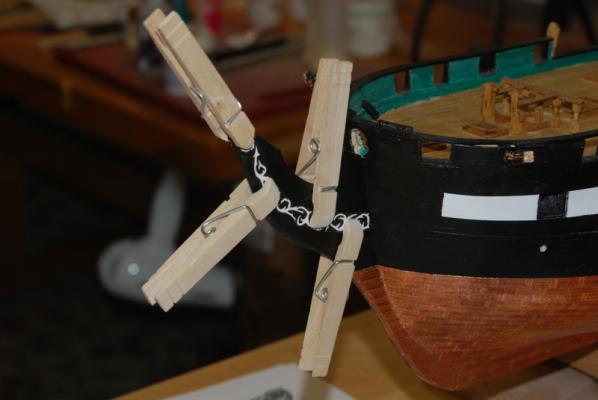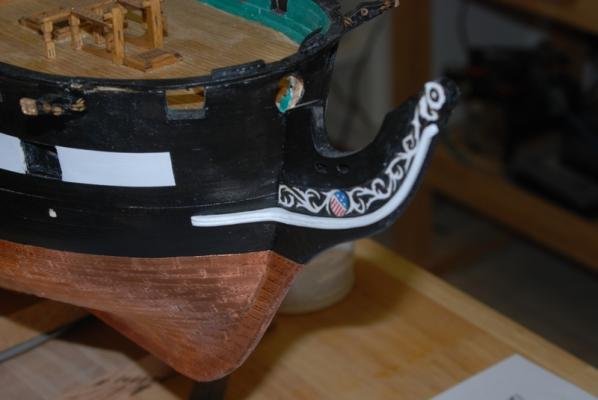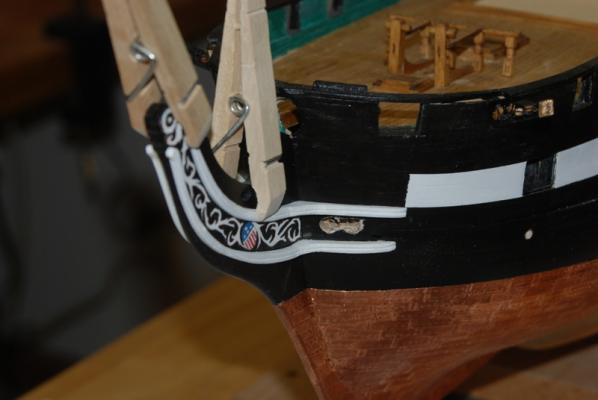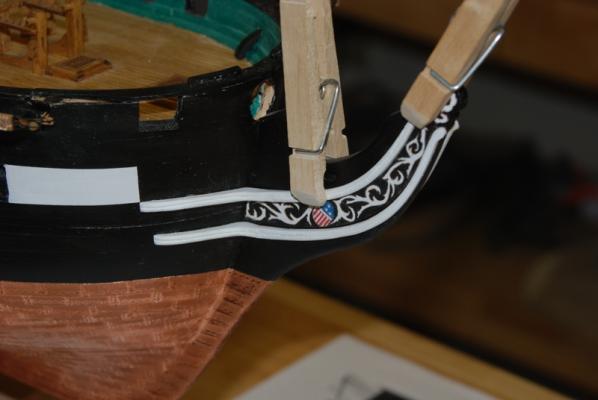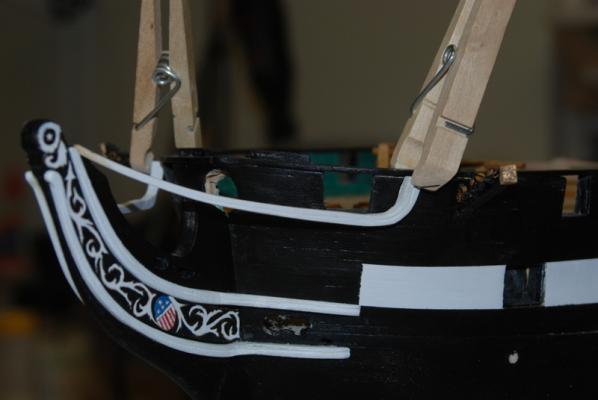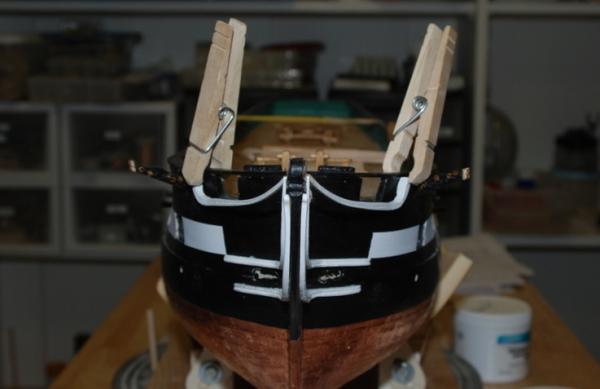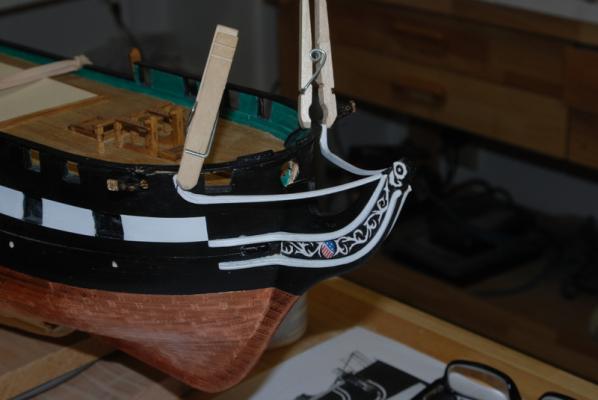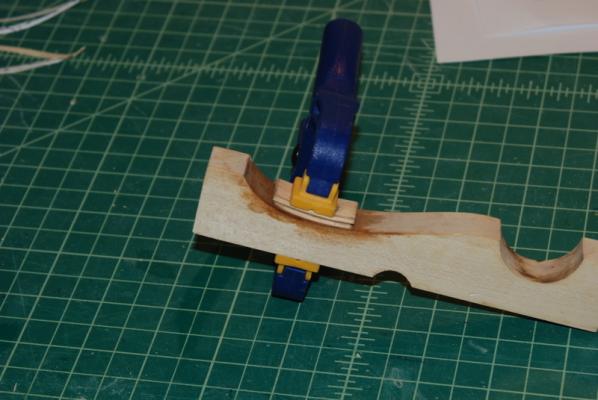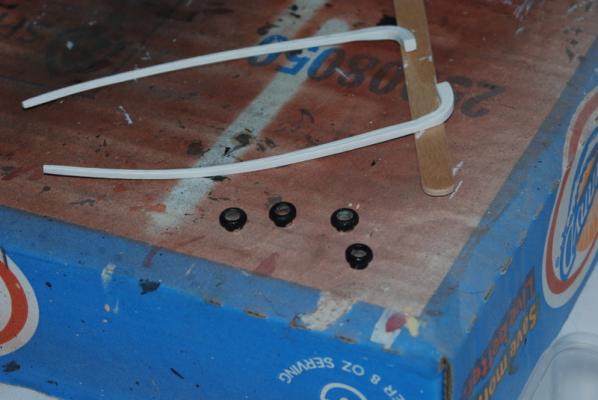-
Posts
2,407 -
Joined
-
Last visited
Content Type
Profiles
Forums
Gallery
Events
Everything posted by usedtosail
-
Hi Ken. Nice job on those quarter galleries. I ended up remaking the windows closest to the hull from scratch so they would fit right, but yours look great. That is pretty ingenious to make them removable like that. As for the stern windows, I made mine 5 windows so that it was easier to use the kit supplied transom pieces. I think 6 would have been more historically accurate for 1812, especially since that is what the Hull model shows. I liked the 5 window configuration because the windows look square, whereas with 6 they would look thinner. Anyway you do them, I feel they will look great.
-
Oh yes, this is part of her history, and not a very good part to me.
- 1,350 replies
-
- constitution
- model shipways
-
(and 1 more)
Tagged with:
-
Here are the pictures of the main rail installed and the cross beams to hold the gratings. I was able to fix the white stripe on the port side by painting white above the stripe, then masking it off and repainting the black. Now the gaps on both sides are the same. I have the gratings all cleaned up and I am in the process of staining them. I also made the seats of ease and stained them too. After I install them, I will add the rest of the top rail and the knee at the front of the stem, then plank the area between the middle rail and top rail.
- 1,350 replies
-
- constitution
- model shipways
-
(and 1 more)
Tagged with:
-
Only one word Dave - WOW!!!
- 962 replies
-
- sovereign of the seas
- ship of the line
-
(and 1 more)
Tagged with:
-
Have you seen this topic? http://modelshipworld.com/index.php/topic/12197-bolt-heads-on-brass-strips/?p=369370
-
Ken, because I used the planking to plank part of the gun deck, I ordered more to plank the spar deck. I think I just ordered one of ME's basswood strip packages. I ended up with almost just enough - I had to rip a couple of planks from wider stock to finish the spar deck. I would recommend making up one of the cannons to test the gun port height. I used the dimensions like you for the subsurface and the planking, but the guns were too high in the ports. My solution was to trim down the carriages along the sides.
-
Sal, your attention to detail and your craftsmanship are top notch. This is beautiful work.
- 659 replies
-
- syren
- model shipways
-
(and 1 more)
Tagged with:
-
Thank you George, Greg, Jay, and Sal. And also the likes. Last night I added the main rails, but tonight I need to do some clean up of the paint around the rails. The main fix I need to make is that when I added the main rails, there is a very noticeable difference in the gap between the rail and the top of the white stripe on the port and starboard sides. In the last picture you can see that the white strip is actually thinner on the port side than the starboard side on the end, so I am going to attempt to correct that tonight with some white paint and masking tape. I will have pictures of how it turns out either way.
- 1,350 replies
-
- constitution
- model shipways
-
(and 1 more)
Tagged with:
-
Arthur, if you used the self sticking copper tape that came with the Phantom for the copper plates, these usually stick very well. Did you prep the wood under them? I prime the wood before applying the plates.I also burnish them after I put them on with a popcycle stick. I did this on the Conny I am working on now and I have a few plates where the overlapping edge with the next plate is coming up a little along the top row. I will probably just peel up the offending plate slightly and use a piece of small wire to apply some thin CA glue to the back of the plate, but I haven't done it yet. Maybe you can try something similar for yours.
-
As promised, here are some photos of the hawse pipes. I finished up the head timbers and gave them a few coats of black paint. I used medium CA to glue them in place because there was no good way to clamp them. Since I took those pictures, I have sanded the tops of the timbers to be flush with the top of the middle rail, so I will need to do some paint touch up tonight. Then I need to fit the main rail onto these head timbers.
- 1,350 replies
-
- constitution
- model shipways
-
(and 1 more)
Tagged with:
-
Oh Dave that is so awesome. I am definitely going to use that technique on a future build.
- 962 replies
-
- sovereign of the seas
- ship of the line
-
(and 1 more)
Tagged with:
-

Bolt Heads on Brass Strips
usedtosail replied to mikiek's topic in Metal Work, Soldering and Metal Fittings
I have used tiny drops of medium CA glue on painted metal surfaces to simulate bolt heads. I think that was in one of Chuck's tutorials for adding bolt heads to rudder pintles and gudgeons. -
Ken, I remember having to fiddle with those corner pieces to get them to fit right. As for the AOS book, there has been a lot of criticism about it, so I am not using it too much. It may only suggest what the Constitution may have been like or it may describe a generic frigate, as I saw in one review. So, it is good for what it is but don't use it as a major reference.
-
Greg, I understand. There are many parts of this kit, like the head frames, where I am going with the current version because it is what I have. It is not too hard bashing a kit but it is sometimes hard to keep all the changes straight. Your question actually had me second guessing myself until I looked up my notes, so I do appreciate the questions to keep me thinking straight.
- 1,350 replies
-
- constitution
- model shipways
-
(and 1 more)
Tagged with:
-
Thanks Tim. I am not out of the woods yet, as fitting the head timbers and the middle rail is proving to be quite a challenge.
- 1,350 replies
-
- constitution
- model shipways
-
(and 1 more)
Tagged with:
-
I feel your pain Scott. I broke off many of the bulwark extension on the Conny before I got it planked. One thing I did do that may help you in the future is that when I glued the extension back on, I used a wood strip like you show in the above picture to align it to the other extensions and hold it while the glue dried. This helped me keep them in alignment as they were reguled.
-
Ken, I think to make it easier on myself, most of the beams are at the same positions as the kit bulkheads. I cut them off the bulkheads but left stubs so I could attach the new beams to these stubs. Since I made the main hatch bigger than it is today, based on what I read about the 1812 version, I had to add a beam at each end of the hatch to support the hatch coaming. I got the dimension of the main hatch from the AOS Constitution book. I wouldn't say this is right but it worked for me. I also am not adding the grating over the main hatch because I read it was probably open in the 1812 era.
-
Thank you Nenad, JIm and Greg. Nenad - I love what you are doing with your Cutty, especially all the details at that small scale. Jim - me too. I think that is one of the reasons I wanted to build this model. Your Constellation is coming along nicely. Greg - am going for an Aug 1812 era version of the Conny and in Baimbridge's book A Most Fortunate Ship I found this - 21 SEP 1812 – Bridle ports cut about midway between #1 gun ports and stem. So I left them off this model, even though I had framed them before planking.
- 1,350 replies
-
- constitution
- model shipways
-
(and 1 more)
Tagged with:
-
Thanks Geoff and Rich. At least all of the information is there on the plans, it is just a matter to tease it all out and visualize each part in three dimensions, like you say. I have started assembling the head rails to the hull. I started by gluing the two trail boards in place, since these set the locations of the cheek rails. I very carefully placed the clamps so I did not mess up the paint on these. I glued each cheek rail in place and clamped it with clothes pins until it dried, then glued the next one until all four were added. I used wood glue along the stem and a combination of wood glue with a few drops of CA glue along the hull, since I didn't have a good way to clamp that part of the rails. I then finished the hawse boards by fitting them between the cheek rails on the hull and thinning them down a bit. I also curved them to match the hull curvature by soaking them in water for a few minutes, then clamping them to the jig that came with my plank bender, using a piece of wood over them so the clamp wouldn't mar them. This worked really well, as I let them dry overnight and they retained the shape when I took them out of the jig. I used them as templates to drill the holes in the hull for the hawse pipes. I painted the supplied white metal hawse pipes with black paint around the outside, leaving the inside unpainted. While they were drying I attached the two middle rails to the hull. Before I attached them, I drilled a small hole through the rail where it attaches at the hull, then continued that hole into the hull. I used medium CA to glue the rails to the hull with a piece of wire in the holes to provide some additional support. Once the head timbers are added they will be more secure but I wanted more support now so they would be stable while I fitted the head timbers. After they dried, I used some clippers to snip off the wire flush with the rail. I was able to attach the hawse boards to the hull last night and used a round file to open up the holes so the hawse pipes would fit in. I will have pictures of those in the next post. I have a little paint touching up to do around the rails and the hawse boards, which I will do before I go too much further. Now it is on to the head timbers, but again the plans show these pretty well.
- 1,350 replies
-
- constitution
- model shipways
-
(and 1 more)
Tagged with:
About us
Modelshipworld - Advancing Ship Modeling through Research
SSL Secured
Your security is important for us so this Website is SSL-Secured
NRG Mailing Address
Nautical Research Guild
237 South Lincoln Street
Westmont IL, 60559-1917
Model Ship World ® and the MSW logo are Registered Trademarks, and belong to the Nautical Research Guild (United States Patent and Trademark Office: No. 6,929,264 & No. 6,929,274, registered Dec. 20, 2022)
Helpful Links
About the NRG
If you enjoy building ship models that are historically accurate as well as beautiful, then The Nautical Research Guild (NRG) is just right for you.
The Guild is a non-profit educational organization whose mission is to “Advance Ship Modeling Through Research”. We provide support to our members in their efforts to raise the quality of their model ships.
The Nautical Research Guild has published our world-renowned quarterly magazine, The Nautical Research Journal, since 1955. The pages of the Journal are full of articles by accomplished ship modelers who show you how they create those exquisite details on their models, and by maritime historians who show you the correct details to build. The Journal is available in both print and digital editions. Go to the NRG web site (www.thenrg.org) to download a complimentary digital copy of the Journal. The NRG also publishes plan sets, books and compilations of back issues of the Journal and the former Ships in Scale and Model Ship Builder magazines.



